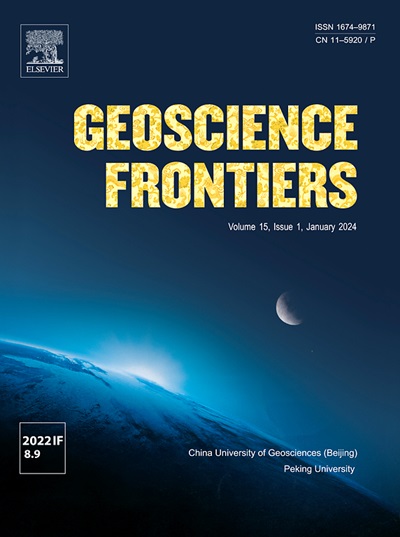In situ Rb–Sr insights in the cooling history of the Petermann Orogeny, Central Australia
IF 8.9
1区 地球科学
Q1 GEOSCIENCES, MULTIDISCIPLINARY
引用次数: 0
Abstract
The Ediacaran–Cambrian Petermann Orogen is a dextral transpressional orogen exposed in central Australia, which facilitated the exhumation of a high-pressure core and the deformation of the Neoproterozoic–Palaeozoic Amadeus Basin. Several studies have investigated the metamorphic and deformational evolution of the Petermann Orogen; however, the spatiotemporal variation of the deformation and cooling history is yet to be fully understood. In situ muscovite and biotite Rb–Sr geochronology, in combination with Ti-in-quartz thermometry is applied to map the spatiotemporal deformation and cooling patterns of the northern part of the Petermann Orogen. Interpreted muscovite Rb–Sr growth ages obtained from samples in the Petermann Nappe Complex (PNC), range between c. 598 Ma and 565 Ma, which correlate with the timing of deformation during the 600–520 Ma Petermann Orogeny. Interpreted muscovite and biotite cooling ages are younger in the east of the PNC (c. 556–541 Ma) and broadly correlate with the regional pattern of crustal heat production, suggesting that the geothermal gradient had a significant control on the timing and duration of cooling. Biotite Rb–Sr cooling ages between c. 555 Ma and 497 Ma for the orogenic core show no correlation with high heat production areas, however, differences in exhumed crustal levels across the Petermann Orogen are observed: high-P granulite facies rocks in the orogenic core vs middle-upper crustal rocks in the PNC, indicating that at least part of the spatiotemporal variation of cooling ages can be attributed to differential exhumation during the Petermann Orogeny. Hence, crustal heat production and differential exhumation were likely the main controlling factors on the duration and variation of cooling rates in the Petermann Orogen.

澳大利亚中部彼得曼造山带冷却史的原位Rb-Sr观测
埃迪卡拉-寒武纪彼得曼造山带是暴露在澳大利亚中部的一个右旋转造山带,它促进了高压岩心的发掘和新元古代-古生代Amadeus盆地的变形。对彼得曼造山带的变质变形演化进行了研究;然而,变形和冷却历史的时空变化尚未完全了解。应用原位白云母和黑云母Rb-Sr年代学,结合石英钛测温,绘制了彼得曼造山带北部的时空变形和冷却模式。从彼得曼推覆复合体(PNC)样品中获得的解释白云母Rb-Sr生长年龄在c. 598 Ma至565 Ma之间,与600-520 Ma彼得曼造山运动的变形时间有关。解释的白云母和黑云母冷却年龄在PNC东部较年轻(约556-541 Ma),并与地壳产热的区域格局广泛相关,表明地热梯度对冷却的时间和持续时间有重要控制。造山带黑云母Rb-Sr冷却年龄介于c. 555 Ma和497 Ma之间,与高产热区没有相关性,但在整个彼得曼造山带的地壳出土水平上存在差异:造山带的高p麻粒岩相岩与PNC的中上地壳岩石,表明冷却年龄的时空变化至少部分可归结于彼得曼造山带的不同出土。因此,地壳产热和差异掘出可能是彼得曼造山带冷却速率持续时间和变化的主要控制因素。
本文章由计算机程序翻译,如有差异,请以英文原文为准。
求助全文
约1分钟内获得全文
求助全文
来源期刊

Geoscience frontiers
Earth and Planetary Sciences-General Earth and Planetary Sciences
CiteScore
17.80
自引率
3.40%
发文量
147
审稿时长
35 days
期刊介绍:
Geoscience Frontiers (GSF) is the Journal of China University of Geosciences (Beijing) and Peking University. It publishes peer-reviewed research articles and reviews in interdisciplinary fields of Earth and Planetary Sciences. GSF covers various research areas including petrology and geochemistry, lithospheric architecture and mantle dynamics, global tectonics, economic geology and fuel exploration, geophysics, stratigraphy and paleontology, environmental and engineering geology, astrogeology, and the nexus of resources-energy-emissions-climate under Sustainable Development Goals. The journal aims to bridge innovative, provocative, and challenging concepts and models in these fields, providing insights on correlations and evolution.
 求助内容:
求助内容: 应助结果提醒方式:
应助结果提醒方式:


